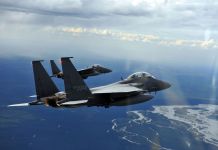US aerospace giant Lockheed Martin, which is eying a fighter jet deal with the Indian Air Force (IAF), is open to setting up a maintenance, repair, and overhaul (MRO) facility in the country, company representatives said.
F-21 Vs F-15EX: Will Indian Air Force Opt For Boeing F-15EX Over Lockheed F-21 Fighter Jets?
Lockheed’s F-21 is competing with Boeing’s F-18, Swedish SAAB Gripen, French Dassault Rafale, Eurofighter Typhoon, and Russian MiG-35 for the supply of 114 medium multi-role combat aircraft (MMRCA) to the IAF.
Michael Kelley, Vice President of Lockheed Martin India, and Brett Medlin, lead of the F-21 India campaign, will hold talks with the Indian government and IAF officials on this multibillion-dollar deal.
Lockheed and Indian business conglomerate Tata Group are already in collaboration to locally manufacture the F-21.
The company had earlier promised that if it gets the MMRCA contract, it would shift its production line to India and will not sell the F-21 jets to any other country, according to LiveMint.

“Once you build an airplane and put it together in the country you also know by extension how to take it apart”, Kelly said.
F-21 Fighter Jet
According to analysts, the F-21 design looks similar to the F-16 Block 70 combat jet. Approximately half of the F-21 and F-16 supply chains are common with the F-22 Raptors and F-35.
The factors which distinguish the F-21 are its airframe, weapons capability, engine matrix, and availability of engine options.
“For instance, the service life airframe in F-21 is approximately 12,000 hours compared to 8,000 hours previously (F-16 Block 70). The additional 40% weapons carrying capability is new in F-21 which was not there in F-16 Block 70. The electronic warfare system will be customized for Indian needs”, according to the experts.
ZERO Buyers! Boeing ‘Hard Sells’ Its F/A-18 Super Hornets To Indian Navy; Global Customers Give It A ‘Royal Snub’
The F-21 jets have been described as the most advanced F-16 variant ever built, incorporating futuristic avionics from F-35 Lightning II and the F-22 Raptor. To differentiate the increased performance and capabilities, it was redesignated as “F-21,” as a specialized offering to India.
Kurt Knust, F-21 Programme Director, @LockheedMartin Aeronautics, explains why the #F21 will truly be a game-changer for the @IAF_MCC and India.#DefExpo2020 #DefExpoLucknow #ForIndiaFromIndia @DefExpoIndia @rajnathsingh @DefenceMinIndia @ProDefLko @DRDO_India @SIDMIndia pic.twitter.com/Ok8gQQsmFa
— Lockheed Martin India (@LMIndiaNews) February 9, 2020
Apart from the traditional boom-delivered refueling facility, the F-21 jets are also equipped with an extendable hose-and-drogue refueling probe.
The F-21 is believed to be a big “Make in India’ opportunity as it brings together the combined strength of US aerospace giant, Lockheed Martin, and Indian conglomerate, Tata Group.
Apart from manufacturing thousands of these jets in India, this program also creates a lot of US supplier-based job opportunities which include hundreds of US-based Lockheed Martin engineering, program management, sustainment, and customer support positions.
Lockheed Martin continues to leverage technologies across its portfolio to drive affordability within new and existing platforms and is committed to delivering the F-21 at the most affordable price for India, according to the company.
Analysts believe, if an MRO unit is established in India, the jets will not be required to be taken to the US or any other country where Lockheed has already set up its MRO units.
Kelly said that he was optimistic that India can make its decision regarding the MMRCA contract by the first quarter of 2022.
When Merlin was asked how the F-21 will meet the requirements of the IAF, which has already acquired 36 Rafale jets from France and has set aside INR 48,000 crore for the state-run Hindustan Aeronautics Limited (HAL) for manufacturing 83 LCA Tejas, he said that the F-21 would complement the Tejas as well as the Rafale jets with respect to their operational capabilities.
Critics writing for the EurAsian Times had earlier stated that little more than a re-branded F-16 that dates back to the mid-1970s, it makes great economic sense from the US perspective to ‘sell’ India to license-build this fighter for the IAF to meet its requirement for an additional 114 combat aircraft to make up for the depleted fighter squadrons.
They further said that with F-16s being phased out of the US Air Force, and their plant at Fort Worth in Texas closing down, moving the aging fighters’ manufacturing unit to India, would keep the line going for few more years, while also providing employment opportunities in the US under ‘America First’ drive.
— Co-authored by Kashish Tandon




